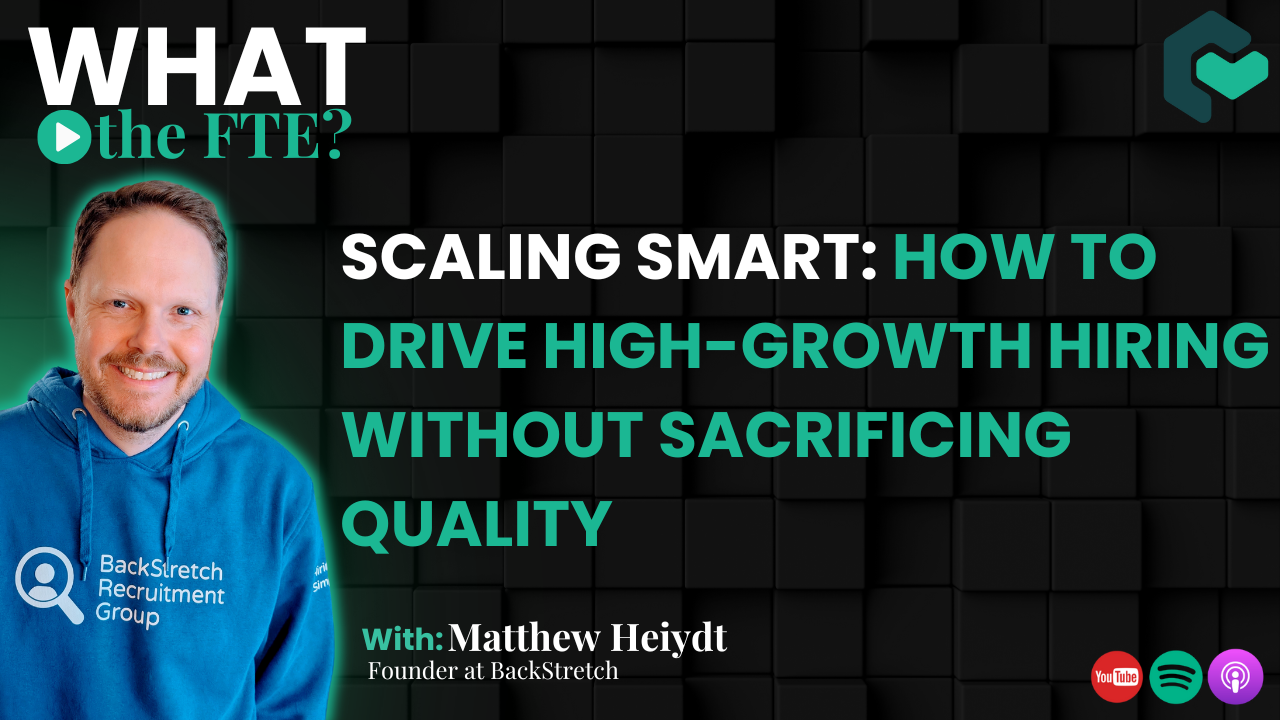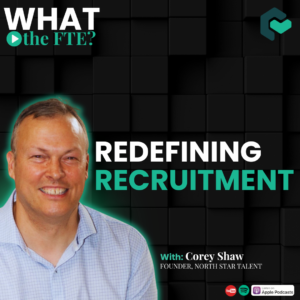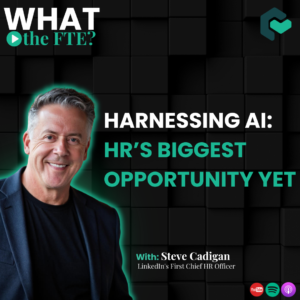What the FTE? is a podcast by Certn where we explore the tough questions surrounding the future of work, risk management, and employee experience. Whether you’re an HR leader, a TA newbie, or simply curious about the changing nature of work, this podcast provides you with practical insights to help you secure your seat at the table.
This week Certn’s CEO, Andrew McLeod, sits down with Matthew Heiydt, Founder of BackStretch Recruitment, to discuss the critical components of hiring at scale. Matthew loves working with leadership teams and creating talent acquisition strategies. In 23 years, he’s helped hundreds of companies through over 12,000 interviews and 3,000 hires. This conversation offers invaluable lessons for HR professionals preparing for rapid expansion in 2025 and beyond.
–
Hiring at scale is hard. If you think you can wing it with the same old processes, you’re setting yourself up for a world of pain. The challenge isn’t just about speed, it’s about scaling while keeping quality intact. If you’re an HR leader in 2025, the question isn’t can you hire fast; it’s can you hire fast without breaking everything?
The ability to hire efficiently while maintaining culture, engagement, and performance is a defining factor of long-term organizational success. This is what I discussed with Matthew Heiydt, Founder of BackStretch Recruitment. We talked about what actually works when hiring at scale, no fluff, just real talk. Matt loves working with leadership teams and creating talent acquisition strategies. In 23 years, he’s helped hundreds of companies through over 12,000 interviews and 3,000 hires. He even helped Certn make 200 hires in under two years. Matt offers invaluable lessons for HR professionals preparing for rapid expansion in 2025 and beyond.
The Balancing Act: Speed vs. Quality
Companies love to brag about how fast they hire, but if speed is your only flex, I think you’re missing the point. According to research by LinkedIn, the average hiring process takes 41 business days. Forty-one. Meanwhile, Matt’s team averages 17 days. How? By cutting out the inefficiencies while keeping the human element intact.
The key takeaway? Process efficiency should enhance, not replace, candidate experience and quality assessment.
1. Closing Candidates: Where Most Companies Get It Wrong
Let’s talk about what keeps hiring managers up at night: closing. It’s one thing to get great candidates in the door; it’s another to actually get them to sign. So why are companies still relying on impersonal offer letters?
Matt puts it bluntly: “We were seeing companies lose top candidates simply because they treated offers like a formality instead of a personal, human moment. That’s when we implemented video offer presentations.”
Instead of emailing a cold offer, Matt says top companies are making the final step feel personal. Video calls, personalized decks, and direct founder involvement are game-changers. Not only does this create a sense of urgency, but it also turns hiring into a relationship, not just a transaction.
Some of the top reasons candidates decline offers include:
- Lack of Personalization: Sending a generic offer letter fails to create an emotional connection. Instead, top-performing companies are embracing video offer presentations, a game-changing tactic where hiring managers and executives personally communicate why they want the candidate to join.
- Lack of Urgency: By treating hiring as a sales process, companies can engage candidates more effectively. Booking immediate follow-up calls, addressing objections in real time, and having executives personally close offers can increase conversion rates dramatically.
- Failure to Align Motivations: Compensation isn’t always the deciding factor. According to decades of recruiting experience, top-tier candidates prioritize growth, leadership, and company culture over salary. Therefore, HR leaders should tailor their messaging to align with what truly drives the candidate.
2. Founder Involvement: The Ultimate Hiring Cheat Code
You want to win top talent? Get your leadership team in the room.
“The difference between hiring and losing a candidate often comes down to whether or not they feel connected to leadership,” Matt explains. “When founders show up in the hiring process—even just for the final call—it signals that this hire matters to the company.”
A surprising but critical insight from scaling hiring successfully is the importance of founder or executive involvement in the process.
This isn’t just about closing deals, it’s about making candidates feel like they’re about to join something special. If you’re scaling and not bringing execs into key hiring moments, you’re leaving offers on the table.
In high-growth startups and even established organizations, top candidates want to see leadership commitment. Executives who engage directly with candidates, particularly in the offer stage, reinforce the vision and mission of the company, making it more compelling than a higher salary elsewhere. HR teams should work closely with leadership to ensure a structured but personal approach to candidate engagement at every stage.
3. Your Employer Brand is Speaking—Are You Listening?
Glassdoor reviews, LinkedIn chatter, employee posts, it’s all shaping how candidates perceive your company. Research shows candidates spend an average of 41 minutes researching a company before deciding whether to engage. And yet, some leaders act like employer brand is an afterthought.
Matt’s take? “Companies who ignore employer branding are setting themselves up for failure. You can’t just talk about culture, you have to prove it, over and over again, through every touchpoint in the hiring process.”
All leaders need to own this. That means proactively managing Glassdoor, engaging with employee stories on social media, and ensuring your hiring process actually aligns with the culture you claim to have.
Actionable Steps to Improve Employment Branding
- Regularly update Glassdoor and LinkedIn profiles with employee success stories
- Encourage employees to share their experiences authentically
- Ensure that employer branding reflects company values beyond perks like free lunches or remote work
- Address negative feedback constructively rather than ignoring it
4. Talent Pools: Build Before You Need Them
Want to know the number one sign your hiring process is about to break? You’re starting every search from scratch.
Top recruiters know that hiring doesn’t start when a job opens, it starts months before. By continuously building relationships with talent, companies can cut hiring lag and avoid desperate, last-minute searches.
Matt sums it up best: “The companies that win the talent war aren’t the ones who scramble when a role opens, they’re the ones who have a warm pipeline, ready to go.”
If your talent pipeline is just an ATS full of ghosted candidates, it’s time to rethink your approach. By working with recruitment partners or leveraging internal talent networks, organizations can reduce hiring lag, maintain a steady pipeline, and ensure a seamless transition when scaling.
5. Hiring at Scale? Get a Partner (and Fire Fast If It’s Not Working)
I’ve learned that hiring at scale requires external expertise. Founders and HR teams often believe they need to build everything in-house, but external partners provide agility and access to wider talent pools. A CEO who continuously asks, “How can we hire smarter and faster?” should also be thinking about which external recruitment partners can help accelerate growth.
When to Partner with External Recruiters:
- When internal hiring bandwidth is maxed out
- When specialized roles require extensive market reach
- When hiring velocity outpaces internal processes
The best partnerships aren’t just transactional; they integrate deeply into the hiring strategy, ensuring the company remains competitive in the talent market.
Though, Matt makes it clear: “A great recruiting partner should make your company faster and smarter. If they’re not doing that, cut them loose.”
By adopting these proven strategies, HR leaders can build high-performing teams at scale without losing the essence of what makes a company great. The organizations that master this balance will be the ones defining the workforce of the future.
The Future of Hiring: What HR Leaders Need to Focus on in 2025
Hiring is only getting more competitive. HR leaders who embrace personalization, speed, employer branding, and strategic partnerships will come out on top.
Hiring isn’t just about filling roles, it’s about shaping the future of your company, and in this job market, the companies who get that will be the ones that thrive.
So, are you just hiring, or are you hiring smart?
Tune into the full podcast: https://certn.co/podcast/
P.S. If you found this article helpful, share it with your team. Let’s make hiring better, together.





